covid
now browsing by tag
Highlighting the Positive of Covid Lesson Planning: Finding the Convergence of Content and SEL
Blog post written by Region 11 Representative, Holly Meade

Holly Meade is a Middle School Visual Arts teacher at Downingtown Middle School. She has a BFA, M.Ed in Childhood Development, and additional certifications in ESL and SEL. Region 11 PAEA rep
I am currently teaching virtually, predicted to soon to be hybrid, but anticipating anything can happen and probably will, going back with 2-days notice, wearing a hazmat suit to class, anything. I counted the amount of times I heard the word fluid during a zoom meeting, 9. Fluid is the new moist, the word is dead to me now, a Covid vocabulary casualty, joining unprecedented. As an attendance check-in, I asked my students to describe 2020 in one word, here are some responses: canceled, oof, oop, crazy, disaster, worst (most popular answer), exhausting, my personal favorite… dumpster-fire (I let that slide as one word), luckily no one used unprecedented. Whatever word you choose to describe what’s going on right now, it’s stressful and become more important than ever that we create a space that’s welcoming, supportive, and safe. An environment where content connects rigor and engagement with social and emotional learning (SEL). A meaningful convergence.
Art teachers are naturals at creating projects which spark joy, are hands-on, engage students authentically and our lesson design process naturally fits into the UbD format. Many school districts are imparting SEL into advisory blocks or guidance department lead lessons, but how do make this sustainable and creatively connect the SEL and content in an authentic way.
You can build upon what your district or individual school has been spotlighting or reinforce it. Many schools are focusing on self-management which is regulating emotions and managing stress. I examined my curriculum and lessons that I would be doing if we were in person and adjusted the content to converge with SEL domains that were not already being covered by school mandated lessons, like stress management. On a side note, I’m not managing my stress well, so I didn’t feel this was a skill I could model at this moment. I do not see recreating lessons as additional work, I see it as an opportunity to examine what is important to creating a safe supportive space that supports social and emotional learning while not sacrificing content or rigor. The examination gave me the opportunity to work SEL into the content lessons in a meaningful way. For example, when reflecting upon the dumpster fire (now one word) that is happening around us. I looked at my own children and how they were feeling powerless and without a meaningful voice. This prompted me to recreate a unit called Artists and Identity and add Voice to the mix. I found it manageable to re-create my content by highlighting just 2 of the 5 SEL domains, self-awareness, and social awareness. Because of the change in teaching format to virtual, I had to recreate how I am delivering content anyway, and when (if) we return to in-person learning, who knows what sharing supplies will look like, so it is great timing for an update. Yes, I found one positive in 2020 lesson planning. Using essential questions that tie emotions with content is another way to practice and model SEL skills while building connections.
Art is empowering. Teaching and modeling how artists use their voice for change and to highlight social issues has been amazing. We are making connections of voice and historical context using Dorothea Lange to the NBA uniforms and the work of a local artist, Russell Craig. I wish I had always given them more opportunity for discussion! We often underestimate how much our students are paying attention to the events of the world and their ability to talk about it. But like Mr. Rodgers said, “Anything human is mentionable and anything mentionable is manageable.” Taking time to create a safe, supportive space is essential for building an environment where students can connect and discuss challenging feelings, which teaches, models, and gives students an opportunity to practice SEL skills like empathy. We do need to evaluate our environments and do everything with compassion. Not just in Covid class, always in our class.
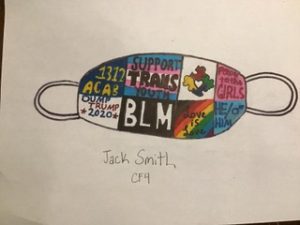
Intro design project building voice, identity, and empathy by letting others see our voice and letting someone else into your world
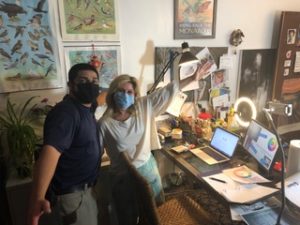
Embracing the chaos with the Comcast technician 20 minutes before hosting virtual Back-to-School Night
Virtual Classroom
Post written by Region 8 Representative, Jillette SmithHello artist-educators!
I originally planned on writing a blog that discussed using a blog space to engage your school community in and outside of the classroom. Although I am writing about just that, my dialogue has changed due to the new “normal” and the transition of being a visual arts classroom teacher to a virtual visual arts educator. Luckily, I have had experience with online learning previously, but that does not say that this was an easy transition. Many administrators and other teachers have not had these experiences and let’s face it; many of our public school districts do not have the technical capacity of an online educational institute. But, I have been a little inventive with what I have learned about online education to help me create a system that works for myself, my students, and their families. This article offers a reflection on how our role as an art educator has changed and explores virtual options to build, maintain, and advocate for a strong online, visual arts program.
Art educators problem solve, prepare lessons, teach curricula, advocate, and maintain our programs in order to enrich students to become independent thinkers who envision, create, and do. Although we are teaching in a new environment, it’s important to remember all of these roles are STILL very much the basis of what we need to do now. With a few modifications and a willingness to grow, we must throw out expectations of 100% class engagement, and forget about the idea of not being a “required to grade” so we can still be an integral teacher that, teaches, advocates and enriches students so that they can continue to flourish in the arts, academically, and just simply be well during the era of social distancing.
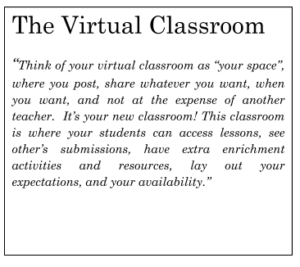 Some days, I know it is hard to look past all the crazy things happening in the real world, but never doubt that we can determine how well we continue to do what we have already done since the beginning of September, and that is: show up and do our best. As we continue to “tread” these new waters’, we aren’t expected to get it right the first time around. Remember, across the state everywhere there is an elementary art teacher who has to email their lessons to a classroom teacher and hope that they get a few submissions in their email. If you are blessed to have a digital platform that gives you your own space such as Google Classroom, Blackboard, or Schoology, you may not feel this on the same level. But a great solution to this is to create or “build” yourself a virtual classroom. Think of your virtual classroom as “your space”, where you post, share whatever you want, when you want, and not at the expense of another teacher. It’s your new classroom! This classroom is where your students can access lessons, see other’s submissions, have extra enrichment activities and resources, lay out your expectations, and your availability. A blog can seem like a big task but it can be free and relatively simple. There are blog builders that are extremely user friendly through Google Sites, Weebly, and I am sure the list goes on if you do a web search.
Some days, I know it is hard to look past all the crazy things happening in the real world, but never doubt that we can determine how well we continue to do what we have already done since the beginning of September, and that is: show up and do our best. As we continue to “tread” these new waters’, we aren’t expected to get it right the first time around. Remember, across the state everywhere there is an elementary art teacher who has to email their lessons to a classroom teacher and hope that they get a few submissions in their email. If you are blessed to have a digital platform that gives you your own space such as Google Classroom, Blackboard, or Schoology, you may not feel this on the same level. But a great solution to this is to create or “build” yourself a virtual classroom. Think of your virtual classroom as “your space”, where you post, share whatever you want, when you want, and not at the expense of another teacher. It’s your new classroom! This classroom is where your students can access lessons, see other’s submissions, have extra enrichment activities and resources, lay out your expectations, and your availability. A blog can seem like a big task but it can be free and relatively simple. There are blog builders that are extremely user friendly through Google Sites, Weebly, and I am sure the list goes on if you do a web search.
To date, I do not have every student submitting each lesson, but I still want to show up and try to reach or “hook” more students from week to week. Here are a few things to remember with long-distance communication: to be clear with your availability, a good rule of thumb to respond to your families is 12 to 24 hours during the regular business week. Communication should not just end there, take the time to respond and give feedback to your submissions. Follow up with students or families who have asked questions to ensure that your students’ and families’ questions have been resolved. I wish that I had time to respond to all of my students’ work during the school year with 500+. This is a task that usually doesn’t happen, but I have more time to give to my students now because I don’t have a ton of prep work to do. Because we cannot help troubleshoot with our students, as they work, and when things go wrong so it is important to note that our feedback is where our CONNECTION will grow.
There are many things that we all are missing right now and I personally miss displaying students’ artwork. It was a large part of my week. Art displayed throughout the building always enhances school community engagement. It not only cultivates a warm environment for our students but it advocates every faculty member, every community member, and every administrator who enters our halls. So to make up for this, I created a page in my virtual classroom that showcases student work. To increase the likelihood of others seeing this I will email a link to students and families, I even include my school community! Usually, my message is short and sweet, like; “check out these awesome submissions! Click the link to see!”
As we continue this journey and gear up for a new year in the fall, I hope that you take away some positives from your end of the year reflections. But most importantly I hope you are safe, healthy, and well!
Resources:
https://www.edutopia.org/article/show-must-go-online-arts-teachers-adapt-home-instruction


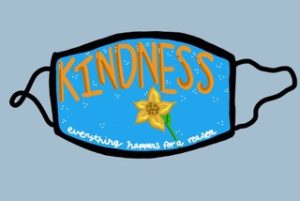
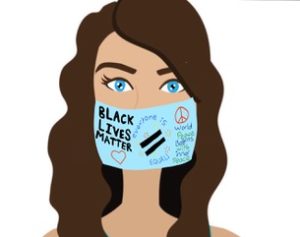
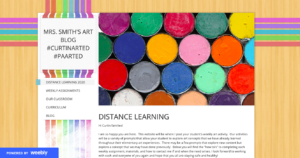
 D5 Creation
D5 Creation